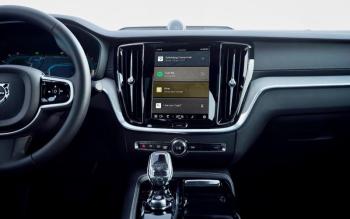Such a caring, customer-centered and safety-conscious carmaker is Volvo that it has somehow infused this family wagon with vitamin B5, presumably to help us fight heart disease.... It’s a nice thought, and possibly appropriate for a company from socialist Sweden, but there are some flies in this ointment. First, Sweden is firmly Capitalistic these days. Second, although Volvo still builds cars in Sweden it has been Chinese-owned (by the Zhejiang Geely Holding Group) since 2010. And third, B5 here refers to what Volvo calls a “mild hybrid” drivetrain.
That is, this car’s 247-horsepower turbocharged four-cylinder gas engine is supplemented with an integrated starter-generator that is hooked up to a 48-volt battery and good for an additional 13 horsepower. The ISG replaces the normal alternator and starter motor. It cranks the gas engine, to start it, then feeds electric power to it when accelerating. While the car is coasting or braking, the ISG works in reverse: Now the gas engine turns it over, to generate electricity that recharges the battery. No need to plug anything in anywhere.
The entire process is seamless and noiseless. Unnoticeable, in fact—the driver knows only that this V60 moves out extra-smoothly, and its automatic stop-start system operates without a hiccup. The impact on fuel efficiency seems to be just as invisible, though: 23 to 30 miles per gallon (city – highway) is good but hardly outstanding these days. So the benefit of mild-hybrid drive here may be largely that it helps Volvo reach its goal of range-wide electrification by 2030.
(It shouldn’t need saying again, but burning fossil fuels is the single worst thing that we do to our planet, and the consequences are becoming more dire by the year, if not the season. Climate disruption is the ultimate self-inflicted wound.)
Volvo offers other “vitamin supplements” too: B4 and B6; that is, powerplants good for 197 horsepower and 295 horsepower, each also with this 13-horsepower ISG and an 8-speed automatic transmission. Stepping up significantly in output, and moving from a MHEV (mild hybrid electric vehicle) to a PHEV (plug-in hybrid electric vehicle), is the Volvo S60 Recharge sedan we drove just a couple of weeks ago.
My comments about that car’s oddball ignition and infotainment controls apply to this wagon, too. Otherwise, the V60 Cross Country is a much different machine: powerful enough for anything short of towing a big fishing boat or horse trailer; capable enough (with an off-road mode, all-wheel drive and heated windshield-washer fluid, seats and steering wheel) to cope with a northern winter; and elegant enough to waft us to a gala at Lincoln center. With a chauffeur, of course.
It is also spacious, comfortable and creamy-smooth, and it handles surprisingly well. This is likely due to the lower center of gravity of a wagon as opposed to an SUV, as well as the extra weight of the ISG and its bigger battery.
One of the things I particularly like about this car is that it really is a car. That is, a wagon, not an SUV, crossover or otherwise. Back in the 1970s, when my friends and I were all getting married, many of our wives—newly infused with domesticity—lusted after Volvo wagons, the squared-off 245DL. This may have been a New England phenomenon because Volvo sales didn’t really take off nationwide until some marketing genius came up with the Cross Country moniker and applied it to a handsome V70 wagon that stood a few centimetres taller on its suspension and was butched up with faux off-road trim.
(The faux part became clear during several of the early press introductions. In Alaska, a writer from I think Esquire Magazine tried to ford a river with a Cross Country wagon and got rolled downstream by the current. He and his passenger survived. And in the UK, I personally managed to tear the trailer hitch off a Cross Country wagon while attempting to go, you know, cross-country on a Scottish moor.)
Volvos have never been inexpensive, but in the context of post-Covid inflation a starting price of $49,750 seems relatively reasonable for a luxury European car. Our sample, though, is the Ultimate trim with a starting price of $56,095. Atop that has been added a cold-weather package, 20-inch wheels, a power tailgate, a premium Bowers & Wilkins stereo and the usual $1,095 destination charge, for a total of $63,565.
Ours is a 2023 model but don’t expect any big changes for the coming year. Volvo seems to be focused on expanding its Recharge-branded family of electric vehicles, especially the compact, battery-powered C40 and XC40 models. That’s OK, though, as this station wagon (there, I said it!) embodies traditional Volvo-ness through and through. We’re all now 50 years older, but we who loved our boxy ‘70s-era Volvo wagons would be even happier with this luscious descendant. Many of our children would be, too.
Next week: GMC Canyon Denali 4WD Crew Cab

































